Olympia, Greece
Image || A copy of Myron’s Discobolus in the Museum of The History of the Olympic Games of Antiquity, Olympia, Peloponnese, Greece. May 7, 2017.
Olympia, Peloponnese, Greece
If the present-day archaeological site of Ancient Olympia, the former celebrated sanctuary of Greek supreme god Zeus and the birthplace of the Olympic Games, doesn’t win gold for being Greece’s most redolent ancient site then it would at the very least be assured of a podium finish.
On the starting line of the Ancient Olympia Stadium, the very first Olympic Stadium. Ancient Olympia, Peloponnese, Greece. May 7, 2017.
dMb Country Overview - Greece
 Greece
Greece
Region – Southeastern Europe/The Balkans (dMb tag: The Balkans). Capital – Athens. Population – 10.8 million. Official Language – Greek. Currency – Euro (€) GDP (nominal) per capita – US$21,000 Political System – Unitary parliamentary republic. EU Member? – Yes (10th member joined January 1981). UN Member? – Yes (founding member joined October 1945). G20 Member? – No. Size – 132,000 km² (Europe’s 15th largest country is approximately half the size of Ecuador, twice the size of Sri Lanka, and roughly the same size as the US southern states of Alabama and Louisiana. Topography – A mountainous interior (80% of Greece is mountainous), a long and convoluted coastline, and hundreds of offshore islands. Independence – 1830 from the Ottoman Empire following 1821 to 1830 Greek War of Independence. Brief History – From the eighth century BC, the Greeks were organised into various independent city-states, known as poleis (singular polis), which spanned the entire Mediterranean region and the Black Sea. Philip of Macedon united most of the Greek mainland in the fourth century BC, with his son Alexander the Great rapidly conquering much of the ancient world, from the eastern Mediterranean to India. Greece was annexed by Rome in the second century BC, becoming an integral part of the Roman Empire and its successor, the Byzantine Empire, which adopted the Greek language and culture. The Greek Orthodox Church, which emerged in the first century AD, helped shape modern Greek identity and transmitted Greek traditions to the wider Orthodox World. After falling under Ottoman dominion in the mid-15th century, Greece emerged as a modern nation state in 1830 following a war of independence. UNESCO World Heritage sites – 18. Tourism Catchphrase/Slogan – All Time Classic. Famous For – Endless coastline and beaches; shipping; democracy (born here); a classical and hallowed past; ouzo; sun-drenched islands; Alexander the Great; the Olympics; being the cradle of Western civilisation; food (tzatziki, feta, souvlaki, moussakas, yogurt, grapes, olives and olive oil); economic collapse & austerity.

Ouzo for sale in the village of Oia, Santoríni, Cyclades, Greece.

Ouzo for sale in the village of Oia, Santoríni, Cyclades, Greece.
Highlights – Cyclades island-hopping and the remnants of all that ancient history (Greece boasts four millennia of sun-bleached ruins, artefacts, and architecture). Greece Titbits – At nearly 14,000 km (8,500 miles), Greece has the 11th longest coastline in the world; Greece is considered the cradle of Western civilisation, being the birthplace of democracy, Western philosophy, Western literature, historiography, political science, major scientific and mathematical principles, Western drama, and the Olympic Games (the country’s rich historical legacy is reflected in part by its 18 UNESCO World Heritage Sites, as of 2017); the Greek economy is the largest in the region with an economy larger than all other Balkan countries combined, this despite its well-documented economic battering and subsequent austerity measures.
Visits – 2 (May 2008 and April/May 2017). Where I Went/What I Saw – Thessaloniki; The Cyclades (Santoríni, Paros, Mykonos, Delos, Tinos); Zakynthos/Zante; Olympia; Sparta; Mystras; Athens.
– On display in the archaeological site of Ancient Olympia
Ancient Olympia & The Olympics It’s a quadrennial event of huge significance today, one of the largest sporting events on the planet, but the very first Olympiad, aka Olympic Games, were held here in Olympia in 776 BC. An ancient Panhellenic celebration held in honour of the supreme Greek god Zeus, who had been worshipped on the site since as early as 1000 BC, the games were undoubtedly the Ancient World’s biggest sporting event in which male competitors would compete naked (the modern word gymnasium derives from the Ancient Greek word for naked) in the likes of foot racing, wrestling, chariot racing and pentathlon, the most revered of all Olympiad events. Staged, and just as it is today, every 4 years (or olympiad, which became a unit of time in historical chronologies), the games pitted against each other the best athletes from various Greek city-states, who would suspend any hostilities (the Sacred Truce) to allow the games to take place, for the paltry prize of a simple wild-olive wreath, the kotinos: status gained as an Olympic winner was a much more coveted prize, the highest honour bestowed upon a mortal. The games would reach their zenith by 576 BC and would continue to grow in size and importance over the course of a millennia, that before their abolition in AD 393, after 1,169 years of continuous competition, by the killjoy Roman Emperor Theodosius I – a result of religious dogma, Theodosius had recently converted to Christianity and suspended the games as part of a general crackdown on public pagan festivities.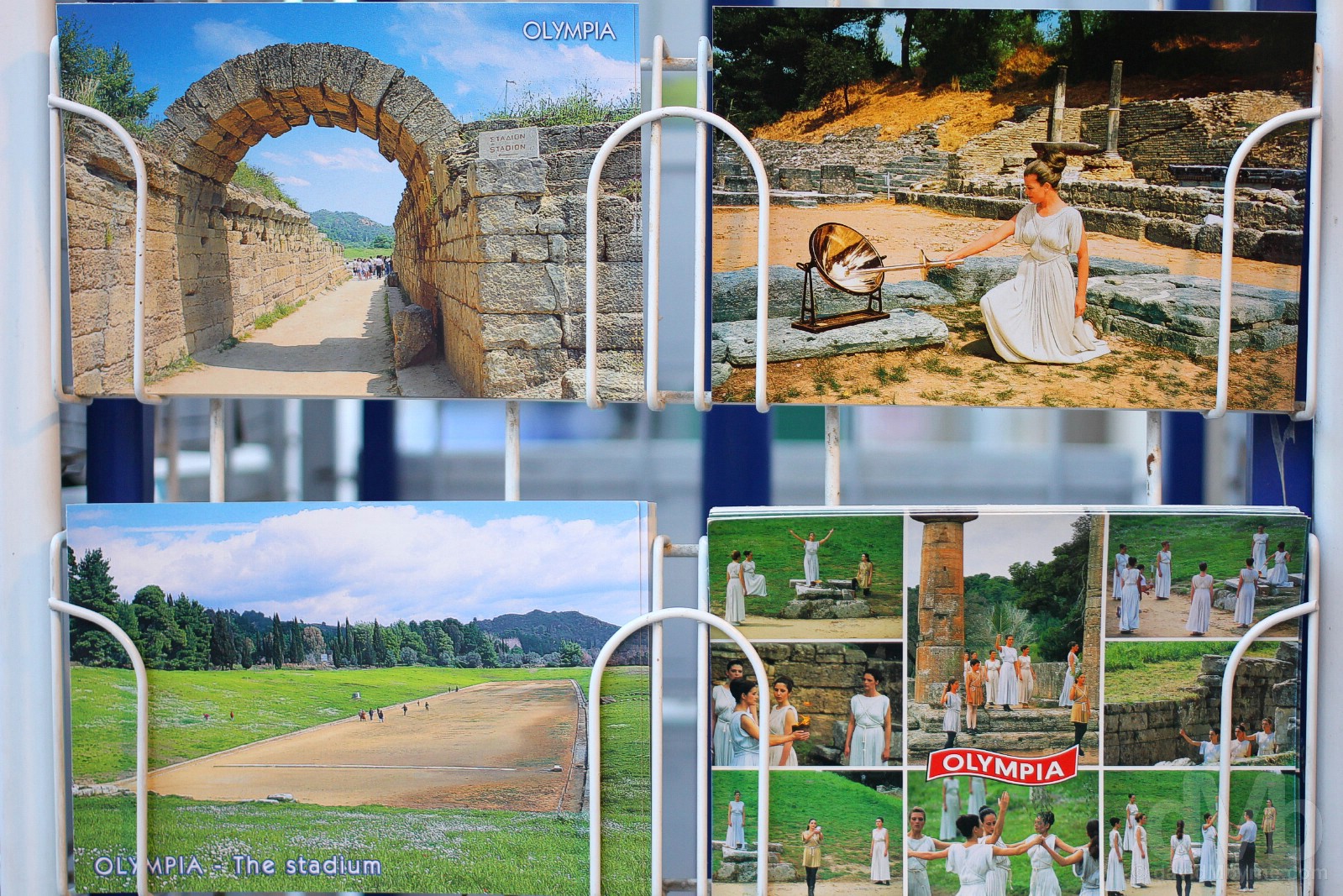
For sale in the modern village of Olympia, Peloponnese, Greece. May 7, 2017.
 other than cancellations attributed to both World Wars, have been held every 4 years in various locations worldwide ever since. Today the archaeological site of Ancient Olympia, located in a fertile and somewhat isolated western Peloponnese valley about 20 kilometres from the waters of the Ionian Sea, is one of Greece’s most evocative ancient sites, one awarded UNESCO World Heritage listed status in 1989.
other than cancellations attributed to both World Wars, have been held every 4 years in various locations worldwide ever since. Today the archaeological site of Ancient Olympia, located in a fertile and somewhat isolated western Peloponnese valley about 20 kilometres from the waters of the Ionian Sea, is one of Greece’s most evocative ancient sites, one awarded UNESCO World Heritage listed status in 1989.
– UNESCO commenting on the Archaeological Site of Olympia

Remaining columns of the symmetrical 3rd century BC Palaestra, thought to have been devoted to the training of wrestlers, boxers and jumpers, in Ancient Olympia, Peloponnese, Greece. May 7, 2017.
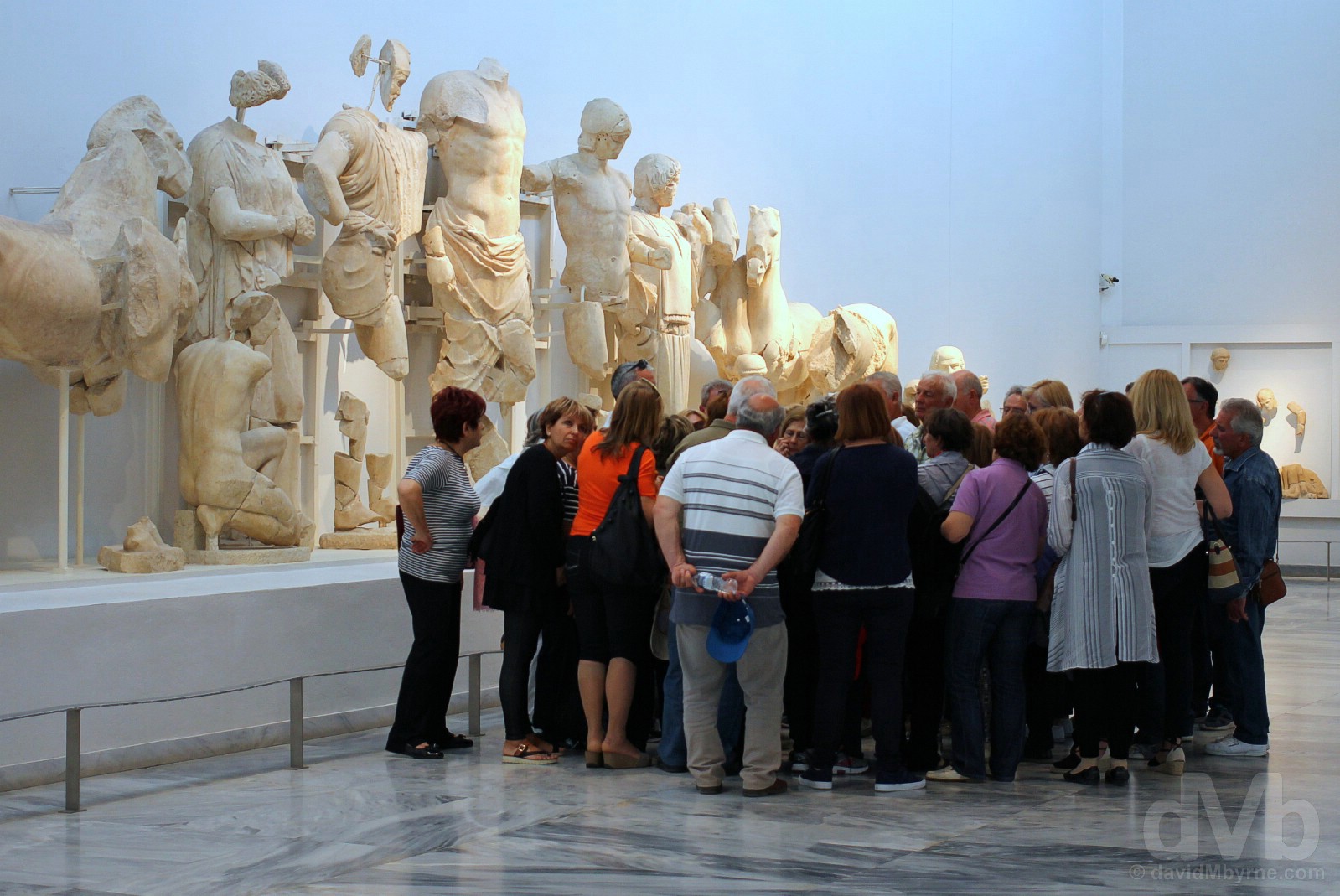
A tour group fronting pediment sculptures of Ancient Olympia’s former Temple of Zeus in Room 5 of the Archaeological Museum of Olympia, Peloponnese, Greece. May 7, 2017.
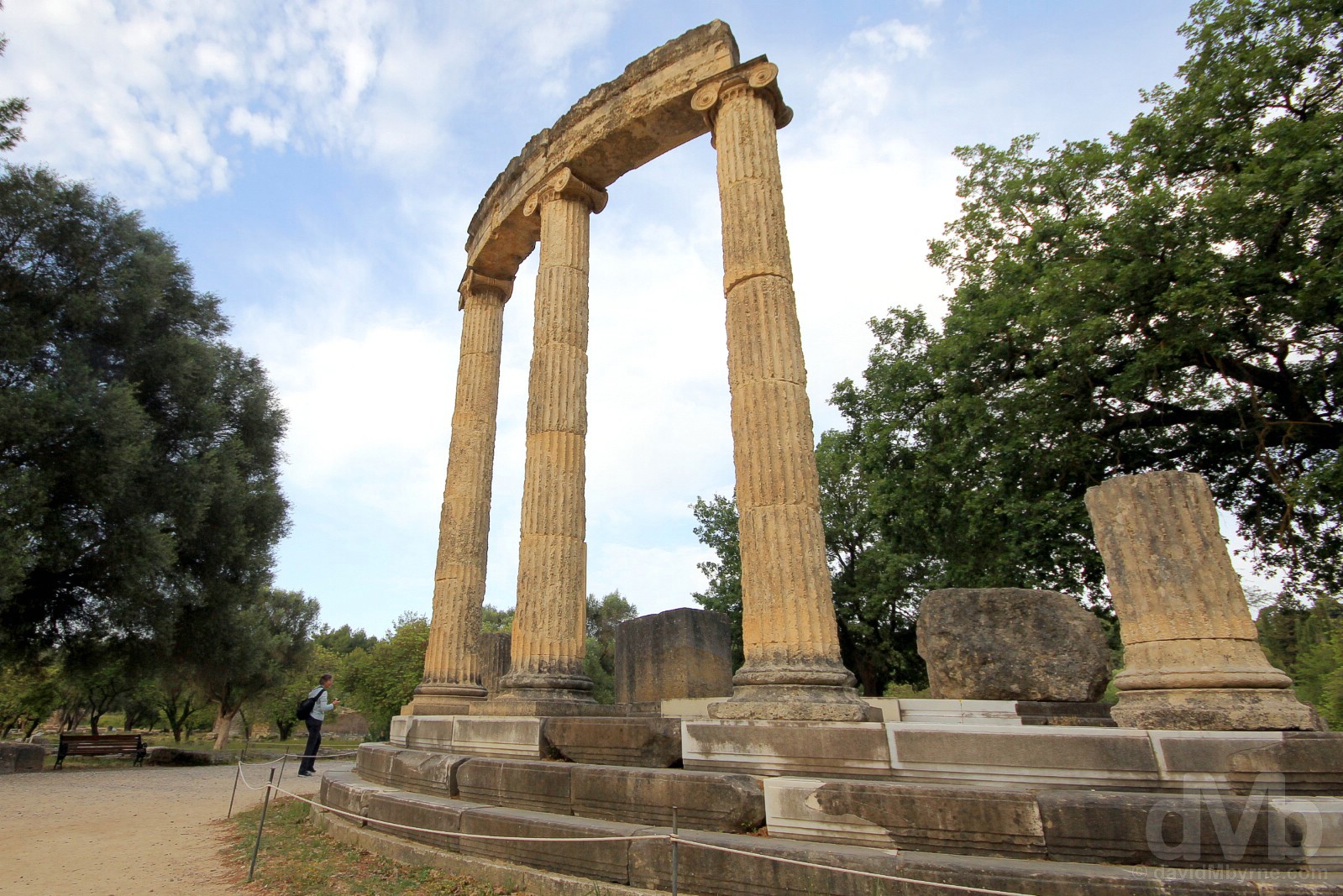
PHILIPPEION | The remaining columns of the Philippeion, Ancient Olympia, Peloponnese, Greece. May 7, 2017.
The foundations and a few Ionic columns are all that is left of the 15-metre-wide limestone and marble Philippeion, the only circular building in the sanctuary of Ancient Olympia. Serving a religious purpose as opposed to a sporting one, it was built to commemorate the 338 BC Battle of Chaironeia where Philip II of Macedon defeated a combined army of Athenians and Thebans giving him control over the Greek mainland. When excavated, the building gave up gold-and-ivory-covered statues of Philip and his family, including his son, Alexander the Great who, it is speculated, may have had a hand in finishing the building.
TEMPLE OF HERA & ALTAR | Hera’s Altar fronting the Temple of Hera, location for the lighting of the contemporary Olympic Flame, in Ancient Olympia, Peloponnese, Greece. May 7, 2017.
Ancient Olympia’s late 7th-century-BC Doric Temple of Hera is both the site’s oldest (it was the first monumental temple built in the Peloponnese) and its most complete temple – some thirty of its columns survive in part, along with a section of the inner wall. The small altar fronting the temple, seen here, would have maintained a continuous fire during the Games, symbolising the fire stolen from the gods by Prometheus; today, the Olympic Flame is lit here in a ceremony that marks the official start of the contemporary Olympic Games, a ritual that began in 1936 for the Games of the XI Olympiad in Berlin.
ANCIENT STADIUM | The Stadium of Ancient Olympia, Peloponnese, Greece. May 7, 2017.
This may not look like much, but this was the world’s very first Olympic Stadium. Laid out sometime in the 5th century BC, at a time when the Games had lost their purely religious character and had become more of an athletic and social event, this is the third iteration of a stadium on the Ancient Olympia site, the popularity of the Games outgrowing the previous two. The early site excavations of the 1870s by German archaeologists first investigated unearthing the stadium, but it wasn’t until German excavations of the early- to mid-1940s that the entire monument was uncovered, allegedly on the direct orders of Hitler. Most recently, the ancient stadium relived its former glory by hosting the shot put event of the 2004 Athens Olympic Games.
ANCIENT STADIUM | The Altar of Demeter Chamyne (foreground) and the judges’ exedra (background) on the banks of the Ancient Stadium in Ancient Olympia, Peloponnese, Greece. May 7, 2017.
There was space enough on the surrounding embankments of the Ancient Stadium for 45,000+ spectators (male only – women and slaves had to make do with watching from the site’s Hill of Krónos to the north). The only permanent seating was facilitated by a stone platform, exedra, for the judges (‘Hellanodikae’) on the south embankment, still in situ today and seen here across the 30- to 34-metre-wide track from the north bank’s small Altar of Demeter Chamyne, whose priestess was the only woman allowed to watch the games.
ANCIENT STADIUM – START/FINISH LINE | The start/finish line of the Ancient Stadium of Ancient Olympia, Peloponnese, Greece. May 7, 2017.
Ancient starting blocks. Two marble slabs with groves for feet and set 192.27 metres apart – that is one Olympic stade or six hundred Olympic feet – separated the start and finishing lines, a distance Usain Bolt would cover in about 20 seconds. Needless to say, I was in no such hurry and spent a lot longer than that sauntering from one end of the hard-packed clay track to the other kicking up dust as I went.
TEMPLE OF ZEUS | The ruins of the Temple of Zeus in Ancient Olympia, Peloponnese, Greece. May 7, 2017.
Both geographically and spiritually the centre of Ancient Olympia, the incomparable (for a time Temple of Zeus was, at 70 metres long, 29 metres wide and 21 metres high, Ancient Olympia’s largest edifice – at its height, the Temple of Zeus made Ancient Olympia the envy of the entire ancient world. Slightly smaller although much taller and some two decades older than the still-standing Partheon of the Athens Acropolis, the massive stucco covered limestone structure was built c. 470-457 BC at the height of the Ancient Olympic Games. The peripteral temple was adorned with 34 Doric columns and unparalleled sculptural decoration in the form of its pediment sculptures (see below), while the temple’s cella enshrined a colossal 13-metre-high chryselephantine (gold and ivory, from Greek chrysos, ‘gold,’ and elephantinos, ‘ivory’) statue of the supreme god Zeus, made by the renowned sculptor Pheidias (c. 480-430 BC) in his workshop on the site at Olympia – the statue, erected in the temple in 430 BC, was one of the Seven Wonders of the Ancient World and was later carted off to Constantinople, present-day Istanbul, by Theodosius II and was lost in a fire in AD 475. In hindsight, I guess the odds against the temple itself surviving from antiquity were slim – it was largely destroyed as part of the imperial decree of AD 426, although earthquakes in AD 522 and AD 551 added to its demise. Today a lone column in the northwest corner of the temple has been restored and re-erected, completed in time for the staging of the Games of the XXVIII Olympiad in Athens in 2004, helping to put into some kind of perspective the majesty of the structure, as does the vast array of column drums still littering the ground surrounding the ruined temple – more than any other Ancient Olympia structure, it’s the ruinous state of the Temple of Zeus that best illustrates the fall of this once-great sanctuary.
Viewing a scale model of the Temple of Zeus below a painted representation of Pheidias’ 430 BC chryselephantine Statue of Zeus, one of the Seven Wonders of the Ancient World, in the Archaeological Museum of Olympia, Peloponnese, Greece. May 7, 2017.

Helmets of the Archaic-Classical periods, believed donated to Zeus by returning victorious hoplite (foot soldiers) and some of the 140,000 bronze artifacts preserved buried in the Ancient Olympia soil, by far the largest number ever found in a region of the ancient Hellenic world, on display in Room 2, Bronze Objects, of the Archaeological Museum of Olympia, Peloponnese, Greece. May 7, 2017.

The Nike of Paionios in Room 6 as seen from the marble seating in Room 5 of the Archaeological Museum of Olympia, Peloponnese, Greece. May 7, 2017.
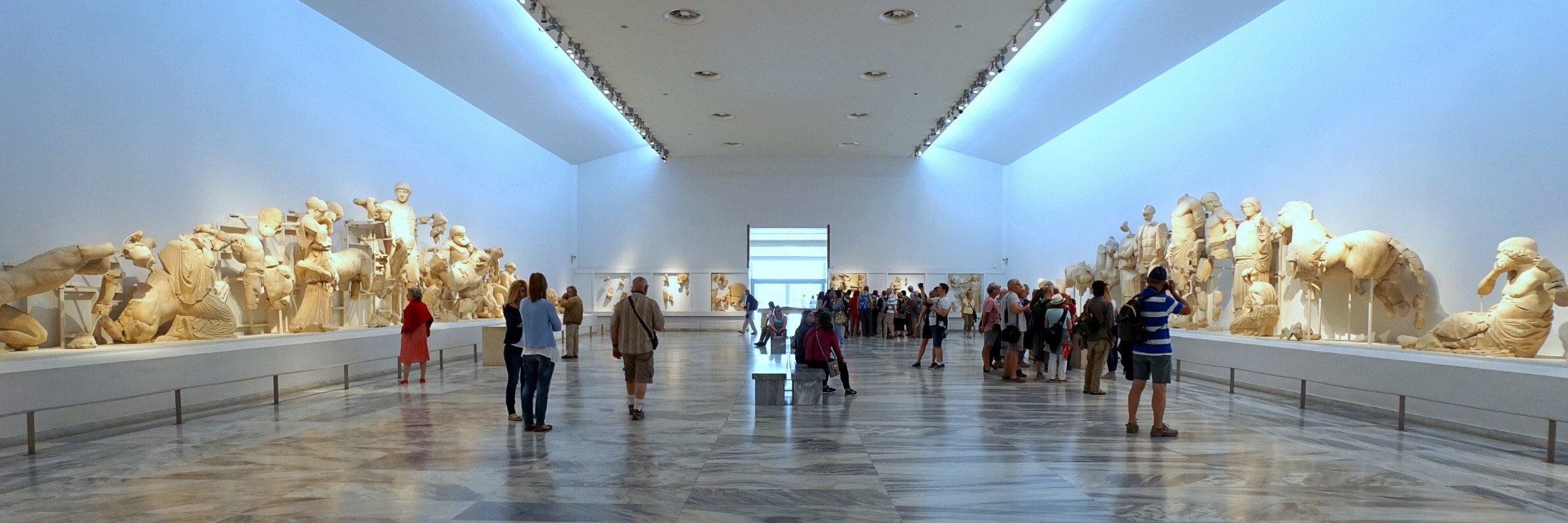
TEMPLE OF ZEUS PEDIMENTS | The central Room 5, displaying the remaining pediment sculptures from the Temple of Zeus, of the Archaeological Museum of Olympia, Peloponnese, Greece. May 7, 2017.
The present building housing the Archaeological Museum of Olympia dates to the early 1970s and was extensively renovated in 2004 ahead of the Athens Olympics. The 12 rooms of the museum encircle its central display hall, Room 5, seen here, displaying what is the centrepiece of the Olympia finds, and what for many is the highlight of their Ancient Olympia adventure, the unearthed statuary and sculpture reassembled from both pediments of the site’s Temple of Zeus. An astonishing sight, the 42 figures (21 on each pediment), carved in the round from Paros marble and dating to the 1st half of the 5th century BC, comprise what is one of the best surviving ensembles from ancient Greek works of art. The eastern pediment (seen here to the right), entitled ‘The Chariot Race of Pelops and Oinomaos’, depicts the chariot race between Pelops and Oinomaos and boasts an almost 3-metre-high central figure of Zeus which dominates the work. The western pediment (to the left), entitled ‘Battle of Lapiths and Centaurs’, depicts the fight between the Centaurs and Lapiths at the wedding feast of Pirithous and the abduction of the Lapith women by Centaurs, and has a dominant 3.1-metre-tall Apollo as its central figure. Almost as astonishing as the works themselves is the fact that they are attributed to an unknown sculptor, known only as Olympia Master, who was active between 470 and 457 BC.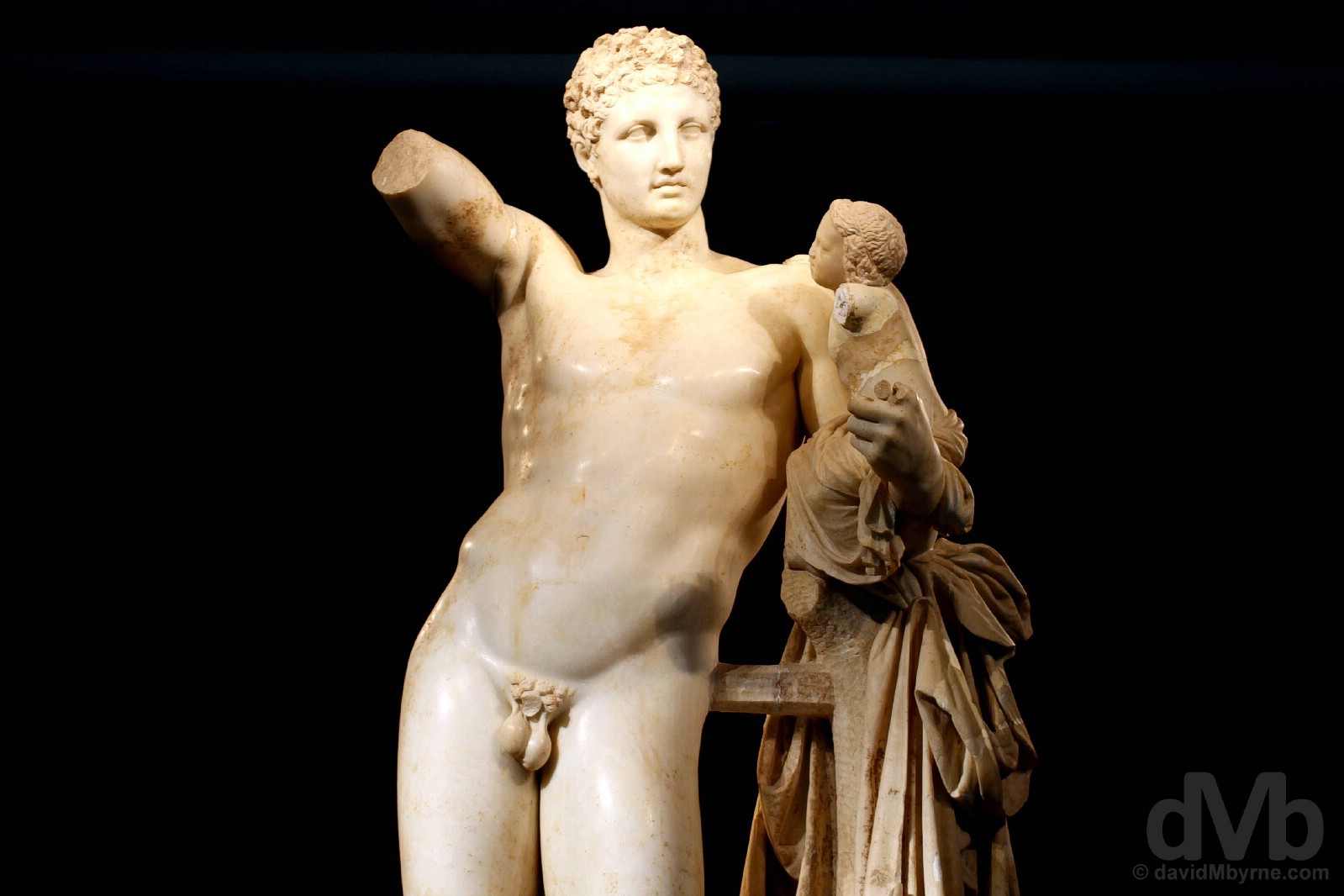
HERMES OF PRAXITELES | The Hermes of Praxiteles, aka Hermes and the Infant Dionysus, on display in Room 8 of the Archaeological Museum of Olympia, Peloponnese, Greece. May 7, 2017.
Vying for the title of the museum’s most revered single piece of work, the Hermes of Praxiteles, commonly known as Hermes and the Infant Dionysus, is one of the masterpieces of ancient Greek art, which probably explains why it gets a museum room, Room 8, all unto itself, one somewhat segregated from the rest of the museum. Standing 2.10 metres high and beautifully carved once again from Parian marble, it’s dated to c. 330/340 BC and was recovered in 1877 from the ruins of the site’s Temple of Hera. It depicts Hermes, Greek god of commerce, cunning, invention and theft, carrying the infant Dionysus in his left arm (it is postulated that his missing right arm is dangling a bunch of grapes which Dionysus, the future god of wine, is reaching out for). Hermes has assumed the contrapposto pose, typical of Classical standing figures, in an effortless and natural way – his hip pushed upward on the right side to support the entire weight of his body. It’s a pose that was widely reproduced in many ancient statues, but the creation of the original form was attributed to Praxiteles, the most renowned Attica sculptor of the day. Although most celebrated Greek works of this period, be they sculptures, paintings etc., were lost and are known to us today solely through inferior Roman copies, this work is assumed a Praxiteles original (no ancient replicas are known to exist), although this is questioned by many an art historian.
PHEIDIAS’ CUP | Pheidias’ cup in on display in Room 7, Workshop of Pheidias, of the Archaeological Museum of Olympia, Peloponnese, Greece. May 7, 2017.
This is way cool. The renowned Athenian sculptor Pheidias (c. 480 – 430 BC) had wowed all with his work on the Acropolis in Athens, specifically the massive chryselephantine statue of Athena Parthenos (c. 438 BC) in The Parthenon, and so was summoned to Olympia to work on the central statue for the Temple of Zeus – little has survived in writing about his life so some contend he actually fled Athens because of charges brought against him of blasphemy against the gods and that he was eventually put to death by the Eleans, those who commissioned him to complete the Statue of Zeus. A huge breakthrough in knowledge of Pheidias’ working methodology came as a result of mid- to late-1950 excavations of the workshop at Olympia where he toiled to create the Statue of Zeus – the discovery enabled archaeologists to re-create the techniques used to make the statue and to accurately confirm its date. Among the tools unearthed, a lot of which are on display in Room 7, Workshop of Pheidias, of the Archaeological Museum of Olympia, was this cup with an inscription on its underside that translates to “I belong to Phidias”. Yep, that’s cool.
NIKE OF PAIONIOS | The Nike of Paionios on display in Room 6 of the Archaeological Museum of Olympia, Peloponnese, Greece. May 7, 2017.
Once found atop a triangular 8.81-metre-high pillar near the southeastern corner of the Temple of Zeus, today the 2.1-metre-high Nike of Paionios, excavated in 1875-1876, occupies Room 6 of the Archaeological Museum of Olympia. Dating to 421 BC and the work of the sculptor Paionios of Mende in Chalkidiki (who inscribed the base of the statue), it is once again carved from Parian marble. It depicts the winged Greek goddess of victory, Nike, descending triumphantly from Olympus. The statue, even in its ruinous state (its spread wings are missing, the goddess is faceless and has no neck or forearms), reveals a strong sense of movement emphasized by her leaning forward, by landing on her left foot, and by the lines of the himation pushing against her vigorous body as if forced by the wind. An iconic figure, the statue became synonymous with the iconographic allegory of victory (it is said to inspire the sense of buoyancy, speed and grace) and has shaped its representation in western art ever since: Nike has adorned every Olympic Games medal since medals were introduced for the Games of the I Olympiad, the first modern Olympic Games in Athens in 1896.– Reproduced from a display in the Museum of the History of the Olympic Games of Antiquity

MUSEUM OF THE HISTORY OF THE OLYMPIC GAMES OF ANTIQUITY | The Museum of the History of the Olympic Games of Antiquity, Olympia, Peloponnese, Greece. May 7, 2017.
Eventually the sheer quantity of ancient and priceless loot being unearthed in Ancient Olympia by archaeologists outgrew the space on offer in the elegant Neoclassical building originally built between 1883-1887 to house the Archaeological Museum of Olympia. Damaged in an earthquake in 1953, the building sat unused for many years following the collection’s move to a new building in 1972, and only as recently as 2004 reopened as the equally fascinating Museum of the History of the Olympic Games of Antiquity. Laid out in 14 thematic groups with over 400 exhibits, there’s plenty to read in here too, a thorough history of the world’s most prestigious sporting competition (the exhibits cover other Panhellenic Games too) as it grew from a local festival in honour of the cult of Pelops, King of the former Peloponnese town or region of Pisa in Greek mythology, to a prestigious quadrennial celebration attended by states from throughout the Greek world, extending the games’ importance and purpose well beyond the winning of olive wreaths.

An ancient floor mosaic depicting athletes on display in the Museum of the History of the Olympic Games of Antiquity, Olympia, Peloponnese, Greece. May 7, 2017.
There’s a real old school museum feel to the exhibition spaces of the Museum of the History of the Olympic Games of Antiquity, with an array of sculptures, mosaics, pottery art and votive offerings on display to highlight the development of the Games, their protagonists and the ritual and culture surrounding it.
DISCOBOLUS | A copy of the Discobolus of Myron on display in the Museum of the History of the Olympic Games of Antiquity, Olympia, Peloponnese, Greece. May 7, 2017.
In a museum highlighting the historical pursuit of athletic achievement and greatness, it was no surprise to see a copy of the Greek sculptor Myron’s iconic Discobolus which has been described as portraying the ‘enduring pattern of athletic energy’ and as being a ‘fantastic representation of the athletic ideal’. One of the most famous sculptures from ancient times and without doubt the most instantly recognisable work of art associated with the Olympic Games, the bronze original dates to c. 450 BC and has been lost, but it has spawned countless Roman copies, mostly in marble. One of the copies, probably the most famous Discobolus of the lot and the first to be discovered (in 1781), is the 1st century AD Discobolus Palombara. Controversially sold to Adolf Hitler in 1938 as a trophy of the Aryan race, it was returned to Italy in 1948 and now on display in the National Museum of Rome. Not much information was given on the piece seen here that I had fun photographing. One of the last pictures I took on this particular day, it turned out to be the photographic highlight of marathon day of absorbing astonishing antiquity in Ancient Olympia.Signing Off | The Complete Olympia Gallery

























